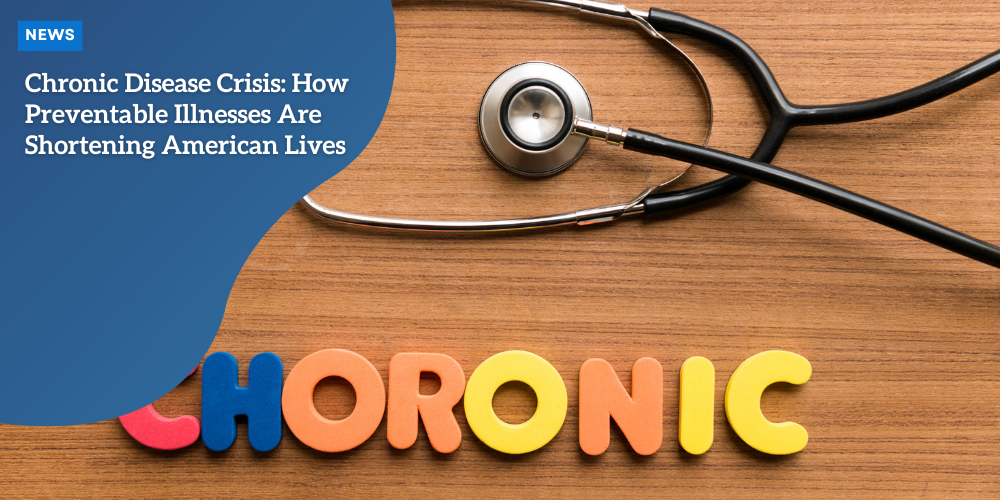Chronic Disease Crisis: How Preventable Deaths Are Shortening American Lives

Anúncios
The Growing Life Expectancy Gap: U.S. vs. Peer Nations
Life Expectancy Trends from the 1980s to Now
The life expectancy gap between the United States and comparable countries has been a growing concern.
In 1980, life expectancy in the United States was fairly similar to that in other affluent nations.
However, since then, a significant divergence has emerged.
While advancements in medical technology and improvements in healthcare have increased life expectancy globally, the pace of improvement has been notably slower in the U.S..
Anúncios
A Slowdown in the 2010s
From the 1980s through the early 2000s, life expectancy in the U.S. increased, but not as rapidly as in peer countries.
This slower improvement continued into the 2010s, when the U.S. saw a plateau in its life expectancy.
In contrast, other wealthy nations continued to see gains.
This plateau reflects underlying issues, such as higher rates of chronic diseases, premature deaths, and various societal and healthcare barriers.
The COVID-19 Setback
The life expectancy situation took a dramatic turn with the onset of the COVID-19 pandemic.
Anúncios
The U.S. experienced a staggering decline in life expectancy in 2020 and 2021, dropping by over 1.5 years.
The decrease in peer nations was less severe, exacerbating the pre-existing gap.
Although there have been some rebounds in 2022 and 2023, the U.S. has not fully recovered to its pre-pandemic life expectancy levels.
Age-Group Specific Impacts
The life expectancy gap isn’t uniform across all age groups.
For instance, death rates in young adults (ages 15-49) have remained relatively unchanged in the U.S. since 1980, whereas they have declined in peer countries.
This has contributed significantly to the overall life expectancy shortfall in the U.S., underscoring the urgency to address the unique health challenges faced by younger populations.
These chronic diseases, premature deaths, and the overall widening life expectancy gap illustrate the pressing need for focused interventions to tackle both healthcare and social determinants of health. Their influence is pervasive across multiple age groups, exacerbating the life expectancy gap in the U.S.

Understanding Premature Deaths in America
The United States experiences significantly higher rates of premature deaths compared to its peer nations.
In fact, the premature death rate in the U.S. is 408 per 100,000 individuals under the age of 70, almost double the 228 deaths per 100,000 seen in comparable countries.
These deaths are considered preventable, suggesting that with different circumstances, these individuals may have lived to at least age 70.
Impact on Life Expectancy Statistics
Premature deaths skew overall life expectancy statistics more dramatically than deaths in older age groups.
When younger individuals die, they account for a larger proportion of life expectancy loss because they miss more potential years of life compared to older individuals who live closer to or surpass the average life expectancy.
Preventable Deaths: A Major Contributing Factor
Factors contributing to high premature death rates in the U.S. include preventable chronic diseases like cardiovascular, chronic respiratory, and kidney diseases, which account for a significant portion of the life expectancy gap.
These illnesses could largely be managed or even prevented through better healthcare access and lifestyle changes.
The Role of External Causes
External factors, such as substance use, contribute considerably to premature mortality rates.
The U.S. sees substance use death rates significantly higher than peer nations, driven by the opioid epidemic and the spread of fentanyl.
In addition to substance use, other external causes include homicides and transport accidents, both of which occur at markedly higher rates in the U.S. compared to other countries.
Addressing the circumstances leading to these premature deaths, through improved healthcare access, preventative measures, and targeted interventions, is imperative.
The impact of premature deaths stretches beyond individual loss, affecting overall public health and the nation’s life expectancy statistics.
Chronic Disease: America’s Silent Killer
Chronic diseases silent killers pose a significant threat to Americans, accounting for a substantial portion of the life expectancy gap between the United States and its peer nations.
Cardiovascular diseases, chronic respiratory diseases, and kidney diseases are particularly notable, contributing to 32% of this gap.
Cardiovascular Diseases
Cardiovascular diseases (CVDs), such as heart disease, stroke, and heart failure, are leading causes of death worldwide.
While advances in medical treatments have reduced CVD mortality rates globally, the U.S. has seen a troubling plateau since 2010.
Americans under 70 are almost twice as likely to die from CVDs compared to their peers, due largely to lifestyle factors and difficulty accessing timely care.
Elevated Diabetes Rates
Diabetes is another chronic disease with dire implications for American life expectancy. U.S. diabetes death rates are 2.5 times higher than in comparable countries.
This disparity underscores the potent combination of poor diet, lack of exercise, and insufficient medical care that many Americans face.
Chronic Liver and Kidney Diseases
The rates of chronic liver and kidney diseases in the United States are alarmingly high, significantly contributing to premature deaths.
These conditions are often exacerbated by high rates of substance use and obesity.
For instance, chronic liver disease and cirrhosis death rates are notably higher in the U.S., highlighting the need for improved public health initiatives and healthcare access.
Chronic diseases remain a critical public health challenge in the United States.
Addressing these preventable conditions requires targeted interventions and systemic changes to enhance healthcare access and better manage chronic illnesses across the population.
The Alarming Rise in Young Adult Mortality
Young adults in the United States are facing a growing crisis.
Death rates in the 15-49 age group have remained almost static since 1980, while peer countries have seen their rates drop by over half.
This stagnation has widened the mortality gap from 20 to over 100 additional deaths per 100,000.
In real terms, Americans are now 2.5 times more likely to die prematurely in this age group compared to those in other affluent countries.
Causes Behind the Numbers
Several factors contribute to this worrying trend.
Chronic diseases take a significant toll, but external factors like substance use and accidents compound the issue.
The rise in opioid use, exacerbated by fentanyl, has made substance use a leading cause of death among young adults.
Meanwhile, homicide and transport accidents present added risks, with rates more than triple those found in peer nations.
A Path to Change
While healthcare advances have saved lives worldwide, the United States lags in translating these gains into reduced young adult mortality.
Addressing social determinants of health could change this trajectory.
Improved access to healthcare and targeted interventions can mitigate these risks, but a collective effort is crucial for long-term change.
As we move forward, understanding the underlying issues will be key to bridging this alarming gap.
Substance Use and External Causes of Death
The Substance Use Epidemic
The United States faces a stark challenge when it comes to substance use deaths, with rates four times higher than those seen in peer countries.
This alarming trend has been largely driven by the opioid epidemic, which has escalated dramatically since the 1980s.
The introduction of potent synthetic opioids like fentanyl has exacerbated this crisis, causing substance use deaths to soar to six times their previous levels.
Substance use deaths among Americans aged 15-49 are over five times higher than in comparable countries, highlighting the immense toll this crisis takes on young adults.
In 2021, the substance use death rate for this age group was 35 per 100,000 in the U.S., compared to just 6.5 per 100,000 in peer countries.
External Causes: Homicide and Accidents
Beyond substance use, external causes like homicide and transport accidents also significantly impact young Americans.
The U.S. homicide rate is nearly eight times higher than that of peer nations, driven by factors such as the prevalence of firearms.
This drastically higher homicide rate disproportionately affects young adults and contributes to the widening life expectancy gap.
Transport accidents are another critical area where the U.S. outpaces its peers.
The country’s greater reliance on automobiles, larger vehicles, and less prevalent public transportation options lead to more accidents and fatalities per capita.
The Impact on Life Expectancy
Deaths due to substance abuse and external causes occur more frequently among younger populations, pulling down the overall life expectancy more than deaths among older adults.
The U.S. death rate from these external causes and substance use is so high among the under-70 population that it contributes significantly to the life expectancy gap between the U.S. and other affluent nations.
Addressing these issues involves not just public health measures but also tackling deeper social determinants of health.
From improving mental healthcare access to implementing strict regulations on opioid prescriptions and controlling firearm-related violence, a multifaceted approach is essential to curb these premature deaths and bridge the life expectancy gap.
Improving these aspects of healthcare and society will be crucial as we look to further understand the broader determinants of health and access to healthcare in the U.S.
Social Determinants and Healthcare Access
Barriers to Proper Diagnosis and Management
Access to healthcare is a major factor affecting life expectancy in the U.S.
Chronic diseases such as cardiovascular, respiratory, and kidney diseases require ongoing medical care and management.
However, many Americans face significant barriers to accessing necessary healthcare services.
Limited access to healthcare prevents timely diagnosis, making it difficult to manage these conditions effectively.
Influence of Social Determinants
Social determinants of health, including economic stability, education, and neighborhood environments, play a critical role in health outcomes.
Diet, smoking, and alcohol use patterns are significantly influenced by these social determinants.
For example, individuals in lower-income communities might have limited access to healthy food options, contributing to a higher prevalence of obesity and diabetes.
Financial Barriers in the U.S. Healthcare System
The U.S. healthcare system is unique in its complexity and the financial barriers it creates.
The lack of affordable care and inadequate insurance coverage are significant issues.
High out-of-pocket costs deter many Americans from seeking preventive care or managing chronic conditions effectively.
This gap in healthcare access leads to higher mortality rates from treatable conditions and contributes to the life expectancy gap.
Addressing these barriers and improving access to healthcare is essential for increasing life expectancy in the United States.
These measures not only improve health outcomes but also prevent premature deaths.
| Scenario | Before COVID-19 | After COVID-19 (Disproportionate Impact) |
|---|---|---|
| 📉 Life Expectancy Gap | U.S. life expectancy already trailing behind peer nations, with slow improvements | Pandemic amplifies the existing life expectancy gap, COVID-19 accounting for 24% of the difference in premature death rates |
| ⚰️ Mortality Rates | Stable mortality rates with modest increases in peer nations | 21% increase in U.S. deaths between 2019 and 2021, compared to less than 5% in peer countries |
| 🧑⚕️ Healthcare Vulnerability | No significant disparities in healthcare access or chronic conditions | Increased vulnerability due to healthcare access barriers and high prevalence of chronic conditions |
| 🏥 Social Determinants of Health | Moderate socioeconomic disparities | Economic instability and limited access to quality healthcare exacerbate the impact of COVID-19 |
| 🔄 Recovery Struggles | Gradual improvements in public health indicators | Ongoing recovery challenges as life expectancy gap with peer nations persists |
Addressing the Crisis: Prevention and Intervention
Targeted Interventions for Preventable Conditions
To bridge the increasing life expectancy gap between the U.S. and peer nations, targeted interventions aimed at reducing preventable conditions are essential.
Chronic diseases like cardiovascular ailments, diabetes, liver, and kidney diseases contribute significantly to the life expectancy gap.
Addressing these preventable conditions can unlock critical improvements in public health.
Key interventions include lifestyle modification programs that focus on diet, exercise, and smoking cessation.
Public health campaigns can raise awareness and encourage healthier living, while community-based initiatives can provide support and resources to manage chronic conditions more effectively.
Improvements in Medical Treatment and Technology
Medical advancements play a pivotal role in reducing death rates from chronic diseases and infections.
Innovations in medical treatment and technology have historically resulted in significant declines in mortality rates for conditions like cardiovascular diseases and HIV/AIDS.
For instance, the death rates for neonatal disorders and congenital birth defects have decreased by nearly 65% since 1980.
Continued investment in healthcare research and the development of cutting-edge treatments are essential.
Also, expanding the use of telemedicine can increase access to specialized care, especially for those in rural or underserved areas.
Reducing Barriers to Healthcare Access
One of the biggest hurdles in managing and preventing chronic diseases in the U.S. is access to healthcare.
Barriers such as lack of affordable care, adequate insurance coverage, and logistical challenges need urgent attention.
Expanding Medicaid and ensuring broader coverage under the Affordable Care Act are steps in the right direction but need to be built upon.
Addressing social determinants of health, such as economic stability, education, and community support, can also improve access to care.
Ensuring that individuals have the means to seek timely medical advice and adhere to necessary treatments can drastically reduce premature deaths and close the life expectancy gap.
Through these targeted interventions, medical advancements, and improved access to healthcare, significant strides can be made in addressing the chronic disease crisis.
Strengthening these aspects is crucial for advancing the health and longevity of the American population.
Next, we’ll examine the social determinants driving health disparities in more detail.






